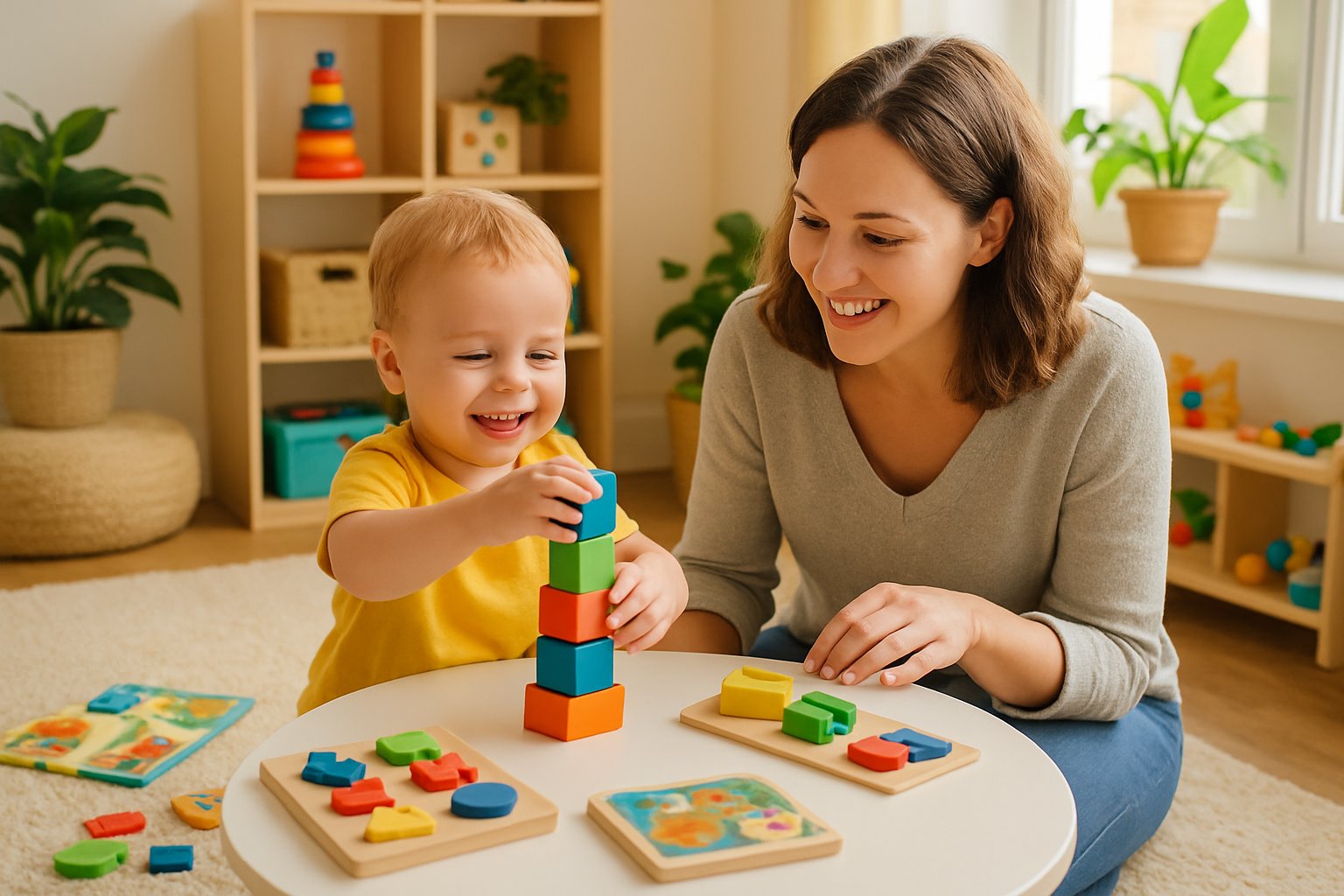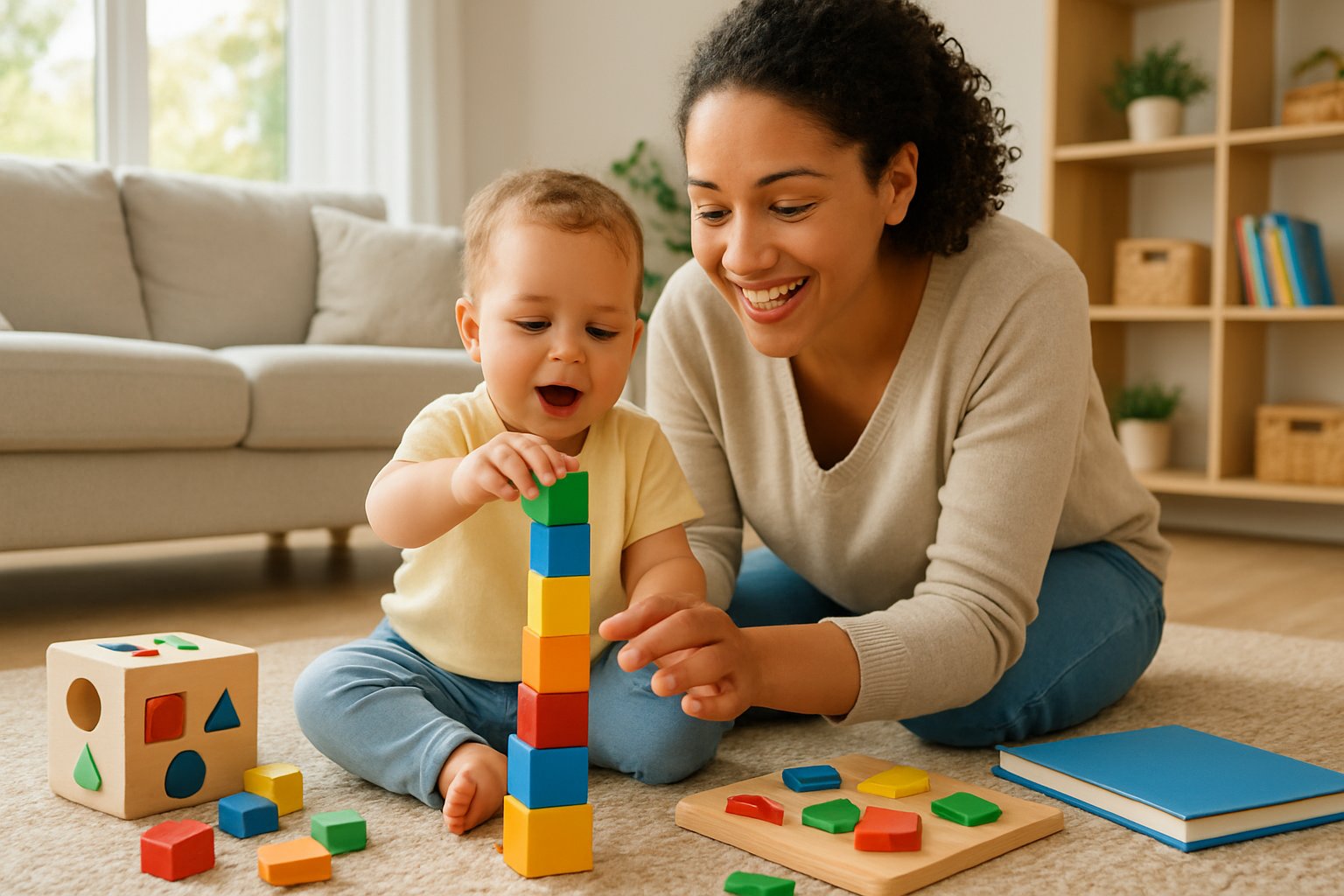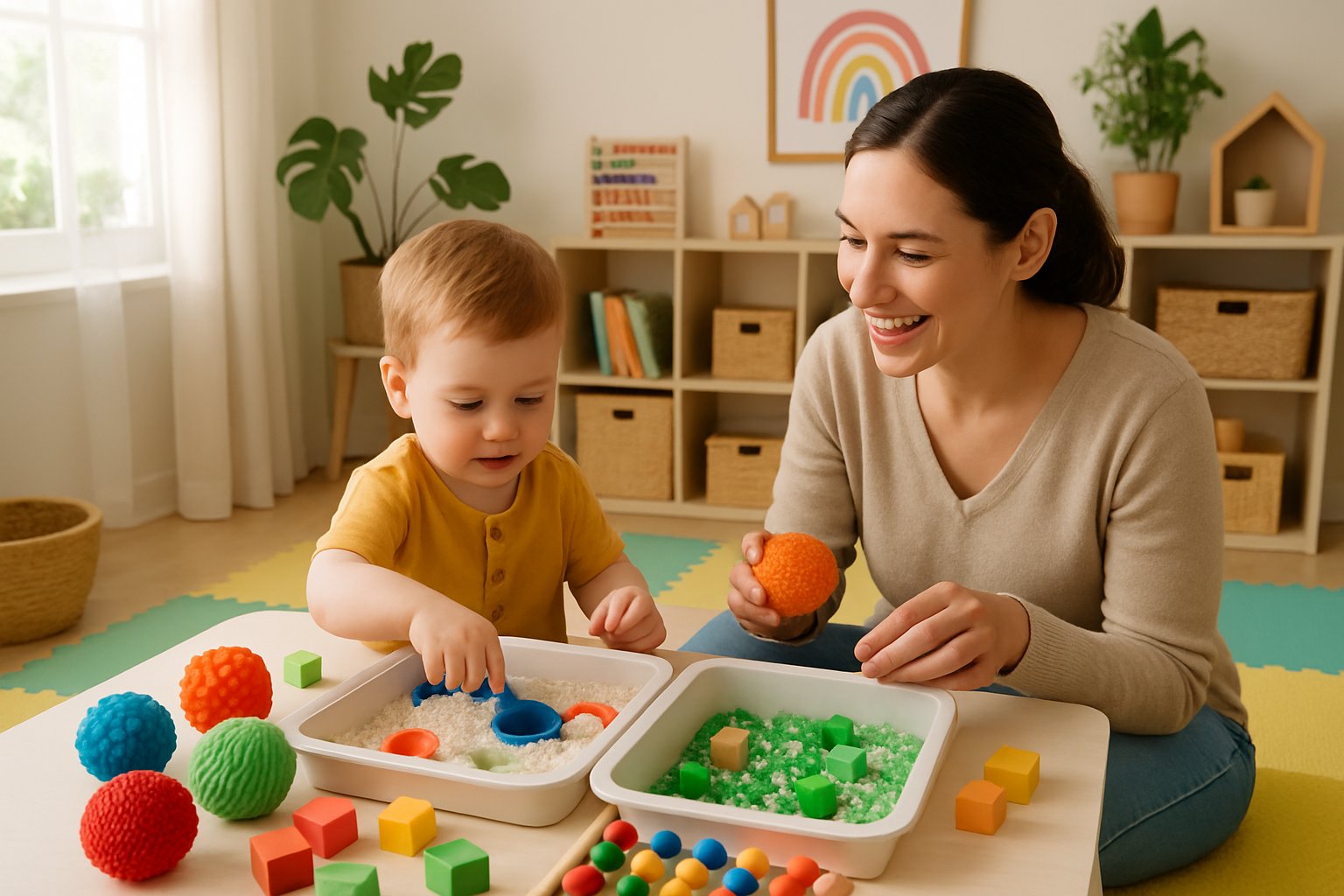Many parents think play is just fun time for their toddlers, but it actually serves as one of the most powerful tools for developing essential life skills.
Through purposeful play activities, toddlers naturally build motor skills, problem-solving abilities, social awareness, and emotional regulation that will benefit them throughout their lives.
Play supports healthy development in cognitive, social, emotional, and physical areas.

The key lies in understanding which activities target specific developmental areas.
Simple games like stacking blocks help toddlers learn spatial relationships and hand-eye coordination.
Playing with other children teaches them to share, take turns, and communicate their needs effectively.
Creative play activities allow toddlers to express emotions and work through difficult feelings in a safe environment.
Parents who incorporate these targeted play strategies into daily routines often see faster skill development and more confident children.
Key Takeaways
- Play naturally develops motor skills, problem-solving abilities, and emotional regulation in toddlers
- Simple activities like building and creative games target specific developmental areas effectively
- Parents can integrate skill-building play into daily routines for ongoing development
Why Play Is Essential for Toddlers’ Life Skills

Play serves as the primary vehicle through which toddlers develop critical cognitive, social, and emotional abilities.
Understanding how different play stages impact development and the role parents play can maximize these learning opportunities.
Understanding the Value of Play for Early Development
Play builds essential life skills across multiple developmental areas simultaneously.
When toddlers engage in simple activities like stacking blocks or playing pretend, they strengthen their brains in ways that formal instruction cannot match.
Cognitive Benefits:
- Problem-solving through trial and error
- Memory development during repetitive games
- Language acquisition through songs and stories
Physical Development:
- Fine motor skills through manipulating toys
- Gross motor skills from running and climbing
- Hand-eye coordination during ball games
Motor skill competence builds confidence for more active play later.
Toddlers who master basic movements become more willing to try challenging physical activities.
Social-Emotional Growth:
- Self-regulation through turn-taking games
- Empathy development during role-play
- Confidence building through mastery of new skills
Play reduces stress and provides an outlet for big emotions that toddlers cannot yet express verbally.
Key Stages of Toddler Play
Toddler play evolves through distinct phases, each building different capabilities.
Play activities enhance creativity and critical thinking as children progress through these stages.
Ages 12-18 Months:
- Solitary exploration of objects
- Simple cause-and-effect games like peek-a-boo
- Mimicking adult actions with toys
Ages 18-24 Months:
- Parallel play alongside other children
- Basic pretend play with familiar objects
- Simple sorting and stacking activities
Ages 2-3 Years:
- More complex imaginative scenarios
- Beginning cooperative play attempts
- Interest in arts and crafts activities
Any activity can be playful to toddlers, whether sorting socks or rolling toy cars.
Each stage offers multiple opportunities to practice emerging skills through repetition and exploration.
Parent Involvement and Its Impact
Active parent participation amplifies the developmental benefits of play for toddlers.
Parents serve as the biggest supporters of their children’s learning through play opportunities.
How Parents Enhance Play:
- Following the child’s lead during activities
- Asking open-ended questions to encourage thinking
- Providing varied materials and experiences
Creating Optimal Conditions:
- Limiting screen time to prioritize hands-on play
- Scheduling regular outdoor play sessions
- Allowing unstructured time for free exploration
Making time for play promotes cognitive, language, physical, social, and emotional development simultaneously.
Parents who engage actively help toddlers make connections between different concepts and skills.
Key Strategies:
- Narrate actions during play to build vocabulary
- Celebrate efforts rather than just outcomes
- Join in without taking over the activity
Sensory Activities to Encourage Learning

Sensory play helps toddlers develop brain skills while keeping activities fun and engaging.
These activities strengthen communication, problem-solving, and adaptation skills through hands-on exploration using all five senses.
Simple Sensory Play Ideas for Home
Parents can create effective sensory experiences using common household items.
A simple rice bin filled with measuring cups and spoons lets toddlers practice pouring and scooping motions.
Water play in the bathtub or sink provides endless learning opportunities.
Add different containers, funnels, and floating toys to help children explore cause and effect.
Kitchen-based activities work well for busy families:
- Mixing different textures in bowls
- Sorting dried beans by size or color
- Playing with ice cubes on a towel
- Exploring spices through smell
Fine motor skills improve when children manipulate these materials.
The activities also build hand strength needed for future writing tasks.
Playdough offers another versatile option.
Children can roll, squeeze, and shape the material while building finger muscles.
Adding tools like cookie cutters or plastic knives extends the learning experience.
Supporting Cognitive Growth Through Sensory Experiences
Sensory play engages multiple senses simultaneously, which helps build neural pathways in developing brains.
When toddlers touch, see, and hear different materials, they create stronger memories and connections.
Problem-solving skills develop through sensory exploration.
Children learn to predict what happens when they mix water with sand or stack different sized objects.
Language skills grow during these activities.
Parents can introduce new vocabulary words like “rough,” “smooth,” “heavy,” or “light” while children explore materials.
Cognitive abilities strengthen when toddlers make choices during play.
They decide which tool to use or how to combine different textures.
Emotional regulation improves through calming sensory activities.
Playing with soft materials or warm water helps children learn to manage their feelings and reactions.
Adapting Activities for Different Ages
Younger toddlers need larger materials to prevent choking hazards.
They benefit from simple cause-and-effect activities like dropping objects into containers or pressing buttons that make sounds.
18-24 month olds can handle:
- Large textured balls
- Musical instruments
- Stacking rings
- Simple water play
Older toddlers can work with smaller objects and more complex tasks.
They can sort items by multiple characteristics or follow simple instructions during sensory play.
2-3 year olds enjoy:
- Cutting playdough with safe tools
- Sorting games with multiple categories
- Building with blocks of different textures
- Art projects using various materials
Activities should match each child’s developmental stage to provide appropriate challenges.
Parents can adjust difficulty by adding more steps or introducing new materials gradually.
Safety remains important at every age.
Parents should supervise all activities and remove small objects that could pose choking risks for younger children.
Building Motor Skills Through Physical Activities
Physical movement helps toddlers develop coordination, strength, and balance while building confidence.
Both outdoor adventures and indoor activities offer unique ways to strengthen gross motor skills through purposeful play.
Gross Motor Development with Outdoor Play
Outdoor environments provide natural challenges that enhance toddlers’ walking skills and build core strength.
Walking on grass, sand, or uneven surfaces forces children to adjust their balance and coordination.
Simple outdoor activities include:
- Walking on curbs or low walls
- Climbing playground equipment
- Running in open spaces
- Jumping over small obstacles
- Playing catch with soft balls
Nature walks offer endless opportunities for movement.
Children can step over logs, climb small hills, or balance on rocks.
These activities strengthen leg muscles and improve spatial awareness.
Playground equipment specifically targets different muscle groups.
Swings develop core stability while slides teach controlled movement.
Monkey bars, even when attempted briefly, build upper body strength.
Weather considerations:
- Rainy days: covered porches or garages
- Hot weather: early morning or evening play
- Winter: snow activities like walking through shallow snow
Creative Ways to Boost Movement Indoors
Indoor spaces can become effective training grounds for gross motor skills with simple modifications.
Homemade obstacle courses using household items challenge children to crawl, jump, and balance.
Indoor movement ideas:
- Pillow jumping courses
- Tape lines on floors for balance walking
- Dancing to music
- Yoga poses for toddlers
- Stair climbing practice
Furniture becomes play equipment with supervision.
Children can crawl under tables, step over pillows, or walk along couch edges while holding hands.
Music adds excitement to indoor movement.
Dancing helps children practice rhythm while moving their whole bodies.
Simple songs with actions like “Head, Shoulders, Knees and Toes” combine learning with physical activity.
Space-saving activities:
- Marching in place
- Stretching exercises
- Balance challenges on one foot
- Wall push-ups at child height
Fostering Social and Emotional Skills Through Interactive Play
Interactive play creates natural opportunities for toddlers to practice communication, cooperation, and emotional understanding in low-pressure settings.
Children with strong social abilities tend to have better academic outcomes and healthier peer relationships as they develop these foundational skills.
Parallel Play vs. Interactive Play
Parallel play occurs when toddlers play near each other without direct interaction.
They might sit side by side with blocks but build separate towers.
Interactive play involves direct engagement between children.
They share materials, communicate about their activities, and work toward common goals.
Most toddlers begin with parallel play around 18 months.
This stage helps them observe social behaviors and learn playground rules without pressure.
Interactive play typically emerges around age 2-3.
Toddlers start asking questions, offering toys, and creating shared storylines during pretend play.
Key differences:
- Parallel play: Independent activities, minimal communication, separate goals
- Interactive play: Shared activities, active communication, collaborative objectives
Parents can encourage the transition by joining parallel play activities.
They can model sharing language like “Can I use the red block?” or “Would you like to build together?”
Encouraging Cooperation and Communication
Building activities foster teamwork and problem-solving skills when children work together toward shared goals. Simple construction projects teach toddlers to negotiate space and materials.
Turn-taking games develop patience and communication. Board games, puzzles, and building challenges require toddlers to wait and express their ideas clearly.
Role-playing scenarios create safe spaces for practicing social scripts. Playing “grocery store” or “doctor” helps toddlers learn appropriate greetings, requests, and responses.
Effective cooperation strategies:
- Use timers for fair turn-taking
- Provide duplicate popular toys to reduce conflicts
- Create group challenges that require multiple children
- Model polite requests: “May I please have a turn?”
Parents should step in when conflicts arise but allow children to attempt resolution first. Gentle guidance helps toddlers develop independent problem-solving abilities.
Developing Empathy and Self-Regulation
Pretend play scenarios help toddlers understand different perspectives. When they care for dolls or stuffed animals, they practice nurturing behaviors and emotional recognition.
Emotion-focused games teach feeling identification and appropriate responses. Simple activities like making facial expressions or discussing character emotions in books build emotional vocabulary.
Play provides opportunities for children to navigate social interactions and resolve conflicts in supportive environments.
Empathy-building activities:
- Comfort play: Caring for “injured” toys or dolls
- Feeling faces: Matching emotions to situations
- Story discussions: Asking “How do you think they felt?”
- Mirror games: Copying expressions and discussing emotions
Parents can use open-ended questions during play to encourage reflection. Questions like “What do you think your friend needs?” help toddlers consider others’ feelings and develop empathetic responses.
Imaginative Play for Problem-Solving and Creativity
Pretend play helps children develop creativity while building critical thinking abilities. Role-playing activities give toddlers safe spaces to practice decision-making and explore different solutions to challenges.
Benefits of Pretend Play
Imaginative play helps children develop creativity and problem-solving skills by letting their minds explore freely. When toddlers engage in pretend play, they practice thinking flexibly about different situations.
During role-play, children face many small problems they must solve on their own. They figure out how to make a cardboard box into a car or decide what happens next in their pretend story.
Key developmental benefits include:
- Critical thinking skills – Children learn to pause and reflect on problems
- Empathy development – Role-playing as others helps them understand different viewpoints
- Communication abilities – Pretend play increases vocabulary and speaking skills
- Creative flexibility – Regular practice makes “thinking outside the box” easier
Imaginative play also helps children increase their vocabulary as they communicate during their pretend scenarios.
Engaging Activities for Imagination Building
Simple household items become powerful tools for sparking creativity in toddlers. A wooden spoon transforms into a magic wand, while empty boxes become spaceships or castles.
Easy imagination-building activities:
- Dress-up games with old clothes, hats, and accessories
- Puppet shows using socks or paper bags
- Building forts with blankets and pillows
- Cooking pretend meals in toy kitchens or with play food
- Doctor visits with stuffed animals as patients
Providing props and toys sets the stage for children’s next creative adventure. These items do not need to be expensive or fancy.
Parents can ask thoughtful, open-ended questions during play without giving answers. Questions like “What do you see?” or “What happens next?” encourage deeper thinking.
Creating story scenes with small toys lets toddlers control the action and make decisions about what characters do.
Parent-Child Role Play Ideas
Joint pretend play creates bonding opportunities while teaching valuable skills. Parents can follow their child’s lead and join their imaginative world.
Effective role-play scenarios:
| Activity | Skills Developed | Materials Needed |
|---|---|---|
| Restaurant play | Communication, math basics | Play food, menus, toy money |
| Grocery shopping | Planning, decision-making | Baskets, empty containers |
| Animal adventures | Empathy, movement skills | Stuffed animals, blankets |
| Community helpers | Social awareness, respect | Uniforms, simple tools |
Leading by example during imaginative play shows children it is safe to express creativity. Parents should provide supportive environments where toddlers feel comfortable exploring ideas.
During reading time, parents can ask leading questions about characters and story outcomes. This connects books to imaginative thinking.
The key is giving children space to work through problems independently while staying nearby for support when needed.
Creative Games and Puzzles to Boost Cognitive Development
The right puzzles and games can significantly enhance a toddler’s thinking skills, memory, and problem-solving abilities. Simple activities like age-appropriate puzzles, coloring with shapes, and educational hide-and-seek games create powerful learning opportunities.
Choosing Age-Appropriate Puzzles
Parents should select puzzles based on their child’s developmental stage and abilities. For toddlers aged 12-18 months, simple wooden puzzles with 2-4 large pieces work best.
Children aged 18-24 months can handle puzzles with 6-8 pieces. By age 2-3, toddlers can tackle puzzles with 12-24 pieces.
Shape sorting games enhance problem-solving skills and fine motor development for toddlers. These activities help children recognize different shapes while building hand-eye coordination.
Key puzzle features to look for:
- Large, chunky pieces that fit small hands
- Bright, engaging images
- Durable materials that withstand repeated use
- Clear shape definitions
Jigsaw puzzles help children develop spatial abilities and problem-solving strategies that support cognitive growth. Start with simple animal or vehicle themes that capture the child’s interest.
Coloring and Shape Sorting for Skill Growth
Coloring activities strengthen fine motor skills while introducing color recognition and creativity. Toddlers benefit from large crayons or markers that are easy to grip.
Shape sorting toys teach children to identify different geometric forms. These games require toddlers to match shapes with corresponding holes or slots.
Benefits of coloring and sorting:
- Improves hand strength and control
- Develops pattern recognition
- Enhances focus and concentration
- Builds color and shape vocabulary
Parents can create simple sorting games using household items like buttons, blocks, or toy cars. Group items by color, size, or type to create engaging challenges.
Combining coloring with shape activities works well. Children can color different shapes while naming them aloud.
Incorporating Hide-and-Seek with Learning
Traditional hide-and-seek can become a powerful learning tool with simple modifications. Hide-and-seek activities help develop object permanence and memory skills in young children.
Hide colorful objects around the room and give toddlers clues to find them. Use descriptive words like “under the red chair” or “behind the tall lamp.”
Educational hide-and-seek variations:
- Hide letters or numbers for recognition practice
- Use toy animals and ask children to find specific ones
- Hide shapes and have toddlers sort them after finding
- Create treasure hunts with simple picture clues
This game type builds problem-solving skills as children process clues and search systematically. It also develops spatial awareness as toddlers learn position words like “under,” “behind,” and “next to.”
Parents can increase difficulty gradually by hiding objects in more challenging locations or giving more complex clues.
Integrating Play into Daily Routines for Ongoing Skill Building
Parents can transform ordinary daily activities into powerful learning opportunities by establishing consistent playful routines, finding the right balance between guided and free play, and gradually building their toddler’s independence through strategic play choices.
Establishing Playful Routines at Home
Morning routines become exciting when parents turn them into games. Toddlers can practice sorting skills by matching socks or organizing their toys before breakfast.
Mealtime offers countless opportunities for skill building. Children develop fine motor skills by using child-sized utensils and pouring their own water.
Parents can encourage counting by asking toddlers to place three crackers on their plate. Bath time transforms into a science lab with simple water play activities.
Toddlers learn about cause and effect by pouring water through funnels or squeezing bath toys. Bedtime routines benefit from incorporating play-based activities into daily routines without extensive planning.
Story time allows children to practice language skills by retelling parts of familiar books.
| Daily Activity | Play Integration | Skills Developed |
|---|---|---|
| Getting Dressed | Race to put on clothes | Independence, sequencing |
| Tidying Up | Sorting game with toys | Organization, categorization |
| Snack Time | Create patterns with food | Math concepts, creativity |
Balancing Structured and Unstructured Play
Structured play provides toddlers with clear goals and boundaries. Parents can set up simple obstacle courses using pillows and furniture to develop gross motor skills.
Unstructured play allows children to explore their creativity freely. Setting out art supplies or building blocks without specific instructions lets toddlers make their own discoveries.
The key lies in alternating between both types throughout the day. Busy family schedules benefit from this approach because it maximizes learning while maintaining flexibility.
Parents should observe their child’s energy levels and interests. Active toddlers might need more physical structured activities in the morning.
Quieter children may prefer creative unstructured time. Transition periods work well for structured activities.
Simple songs or movement games help toddlers move from one activity to another smoothly.
Encouraging Independence Through Play
Self-help skills develop naturally when parents create opportunities for toddlers to practice independently. Simple dress-up clothes with large buttons and zippers help children master dressing skills.
Kitchen play teaches valuable life skills. Toddlers can wash vegetables, tear lettuce, or mix ingredients with supervision.
These activities build confidence while developing practical abilities. Cleanup games make tidying fun rather than a chore.
Parents can set timers and challenge toddlers to put away all the blocks before the bell rings. Choice-making skills grow when parents offer limited options during play.
Asking “Would you like to build with blocks or paint a picture?” helps toddlers practice decision-making. Creative play activities enhance hand-eye coordination and spatial awareness.
These skills directly improve daily task performance and build independence over time.
Frequently Asked Questions
Parents often wonder about the best ways to use play for building specific skills in their toddlers. These common questions address practical strategies for enhancing development through targeted play activities and parental guidance.
What activities can enhance problem-solving skills in toddlers?
Simple puzzles with large pieces help toddlers practice thinking through challenges. Shape sorters teach children to match objects and figure out where pieces belong.
Building blocks encourage toddlers to experiment with balance and structure. When towers fall down, children learn to try different approaches.
Hide-and-seek games develop logical thinking skills. Toddlers must remember where objects are hidden and use clues to find them.
Pretend play scenarios like playing store or kitchen help children work through everyday problems. They learn to make decisions and solve simple challenges during imaginative games.
Water play with cups and containers teaches cause and effect. Toddlers figure out how to pour, fill, and empty different sized objects.
How does imaginative play contribute to a child’s social development?
Pretend play helps toddlers practice social roles they see in real life. They learn about being a parent, teacher, or doctor through acting out these situations.
Playing with dolls or stuffed animals teaches empathy and caring behaviors. Children practice feeding, comforting, and taking care of their toys.
Dress-up games allow toddlers to explore different identities and perspectives. This helps them understand how other people might think and feel.
Role-playing activities teach turn-taking and sharing. Children learn to wait for their turn and cooperate with others during group play.
Imaginative play also helps toddlers express emotions safely. They can act out scary or confusing situations through play to better understand them.
Are there specific toys that foster independence in young children?
Push toys and ride-on vehicles help toddlers move around independently. These toys build confidence in their physical abilities.
Simple musical instruments like drums or shakers let children create their own sounds. They can explore music without needing adult help.
Toys that support self-help skills include dressing boards with zippers and buttons. These help children practice getting dressed on their own.
Stacking toys and nesting cups can be used in many different ways. Toddlers can explore and play without specific instructions from adults.
Art supplies like large crayons and paper encourage creative expression. Children can draw and color independently while developing fine motor skills.
What role does parental involvement play in developing a toddler’s cognitive abilities?
Parents who actively engage in play help expand their toddler’s learning experiences. They can ask questions and point out interesting details during activities.
Narrating play activities helps build language skills. When parents describe what is happening, toddlers learn new words and concepts.
Playing together allows parents to model problem-solving strategies. Children watch how adults approach challenges and learn from these examples.
Parents can extend play by adding new elements or suggesting variations. This keeps activities interesting and introduces new learning opportunities.
Reading books during quiet play time builds cognitive skills. Parents who read regularly with their toddlers support language development and thinking abilities.
How can parents use playtime to improve their toddler’s motor skills?
Fine motor activities like finger painting and play dough strengthen small hand muscles. These skills help with tasks like holding utensils and drawing.
Large motor skills develop through dancing, crawling games, and playground activities. Running, jumping, and climbing build strength and coordination.
Ball games teach hand-eye coordination and balance. Rolling, throwing, and catching balls helps toddlers control their movements better.
Threading large beads or pasta pieces improves dexterity. These activities prepare hands for more complex tasks like writing later on.
Sensory bins with rice or beans encourage scooping and pouring motions. These movements strengthen the muscles needed for self-feeding and other daily tasks.
Can structured play activities affect a toddler’s emotional growth, and if so, how?
Structured activities with clear rules help toddlers feel secure and confident. Knowing what to expect reduces anxiety and builds emotional stability.
Group games teach emotional regulation when children must wait their turn. Toddlers learn to manage disappointment and excitement during structured play.
Daily routines that include play help children understand expectations. This predictability reduces tantrums.
Completing structured activities gives toddlers a sense of accomplishment. Successfully finishing puzzles or games builds self-confidence.
Structured play provides opportunities to practice expressing emotions appropriately. Children learn acceptable ways to show excitement, frustration, or joy during organized activities.

